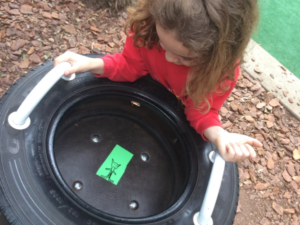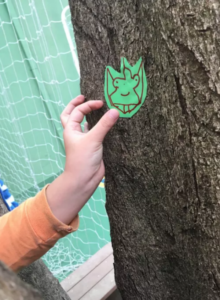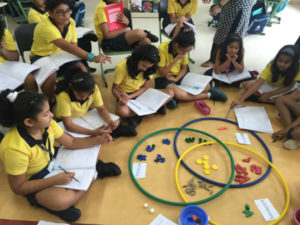 Other than being fun, what are the real academic benefits of game-based learning, asks IB World
Other than being fun, what are the real academic benefits of game-based learning, asks IB World
First came Angry Birds, then Candy Crush, and now Pokémon Go is the latest mobile game to pique the interest of children. But gone are the days when teachers would consider apps and games as nothing but a distraction from education. Instead, schools around the world are embracing the growing trend and transforming mobile apps into effective classroom learning tools.
Game-based learning motivates students by providing praise and encouragement, which can develop and enhance skills such as problem solving and knowledge acquisition, according to the UK’s National Foundation for Educational Research.
It’s not only a fun way to engage students, but new research has found that game-based learning could help students with challenges such as autism improve collaboration and communication skills, and build their confidence.
Improves emotional regulation
Craig Smith, an academic specializing in autism research and Deputy Principal at the Aspect Hunter School for children with autism in Newcastle, Australia, uses Pokémon Go in and out of the classroom. He’s discovered that students’ social skills have improved, and it has also renewed his students’ hunger for learning.
He says the game is one of the most engaging tools he has ever come across during his professional career.
We’ve observed that students are more willing to engage in conversation with strangers, often by starting up conversations about Pokémon, and students are going for independent hunts as a way of meditating and relaxing, which helps create emotional regulation and contributes towards physical health goals,” says Smith.
Games offer a social space for children on the autistic spectrum who may have communication challenges and struggle with face-to-face interaction, according to Sarah Lambert, Head of Policy and Public Affairs at the UK’s National Autistic Society.
“They give children with autism a common interest with others their age, which can make it easier to respond to or start conversations. Pokémon Go has also helped some children with particular anxieties leave the house and travel because it is the first augmented reality game that encourages people to play outside,” she added.
Parents and guardians have responded positively to Smith’s efforts. “Students’ families started retelling amazing stories about their children accompanying them for walks, and connecting socially with others to go Pokémon hunting,” he says.
Following this feedback, Smith put together a learning programme incorporating 10 different Pokémon Go-related educational experiences. He also developed the ‘Special Interests Accessibility Components’ (SIAC) framework to help educators consider ways of using students’ personal interests in their teaching.
It’s important to note that, while the game might be a useful learning resource, talking to strangers and going on independent hunts can be risky. It’s essential for parents, guardians and teachers to collaborate together to ensure hunting trips are both safe and enjoyable.
 Encourages playful exploration
Encourages playful exploration
While Pokémon Go is still making its way into classrooms around the world, IB teachers are using other educational games to encourage expressive teaching and bring learning to life in a variety of ways.
Sana Noor, Primary Years Programme (PYP) Teacher at IB World School Pathways School Noida, in India, says: “Although Pokémon Go is still not available in India, it sounds really fascinating. The whole idea of finding a virtual character in the real world perfectly encapsulates the digital world that we are moving into year after year. If given a chance I would definitely want to try it in my classroom for integrating with concepts like map reading and direction following.”
Pathways school currently uses mathematical apps such as Motion Math and Monster Math; and Jumbled Sentences, which help and support students with their writing skills and word order.
Students enjoy this style of learning: “The students hardly ever realize that they are actually learning, but the concepts cement into their minds,” says Noor.
“I have noticed many a time that students’ understanding of concepts becomes much clearer if they play related games regularly. The whole multimedia aspect makes their comprehension clear since they are able to visually witness the real operation behind that concept, which sometimes is lost in the traditional paper-pen way. For children with particular challenges, games have worked wonders in making them willingly understand a concept.”
Noor has also found that games teach students that making mistakes is ‘Okay’, says Noor: “When playing games, children get enough chances (or lives) to correct themselves, which boosts confidence and makes them believe that it’s alright to make mistakes because they always have another chance.”
Develops language skills
At the Canadian International School of Beijing, China, students play a game called Civilization V, which gives students the opportunity to experience managing an empire throughout the ages and into the future.
Christopher Murray, Grade Four English and Additional Language (EAL) Teacher, initially introduced students to gaming to build trust, but has found it to be a great partner to their educational ambitions. “It provides a constructivist context where students can learn, experiment, reflect, change, and make connections,” he says.
It has also improved his relationships with students. “Along with other strategies, gaming has enabled me to create positive relationships with my students. Too often, students feel like they do not connect to their teachers. This can be especially true within the international school communities where teachers may come from cultures and backgrounds vastly different from those of their students. With gaming, we find a common thread.”
“Gaming also develops language,” adds Murray. “For example, over the years I have noted that many students with limited English language nevertheless possess game-specific English vocabulary. Minecraft, for example, has enabled them to learn words such as: ‘sand’, ‘clay’, ‘gravel’, ‘brick’, ‘wood’, and ‘build’. Through virtual manipulation of these objects, they also learn that each is a different material with different properties.”
In Mumbai, India, iPracticeMath – which helps students practise reasoning, analysing and problem-solving – and Brainpop – which engages through movies, quizzes and concept mapping – are some of the games that have encouraged productive learning at Oberoi International School, says Hemal Panchal, Grade 5B Homeroom Teacher.
Game-based learning gives impetus to children to think critically and creatively to approach complex problems and make ethical decisions,
“It helps them retain what has been learned for longer, which makes the child a lifelong learner. It also gives opportunities to explore new ways of arriving at conclusions, develop conceptual understanding, or demonstrate the attribute of being curious, or even a combination of all.”
 Inspires the IB Learner Profile
Inspires the IB Learner Profile
While there is still some resistance to it, it’s hard to deny that mobile games have a place in today’s classroom.
The Education Arcade at the Massachusetts Institute of Technology found that regular game players are risk-takers who exhibit persistence, attention to detail and problem-solving skills.
It’s also a form of inquiry as games typically get more difficult the longer they are played, meaning students are constantly acquiring new knowledge, says Murray. “The skills and knowledge required to play games to completion is much higher than many people realize,” he says.
Games can develop IB Learner Profile attributes, too. Through social interactions, students can become caring, respectful, and open-minded communicators, believes Murray.
But it’s important for teachers to believe that playing games is beneficial, otherwise they won’t be an effective learning tool, says Noor: “Once we start believing in the power of games, our mind gets attuned to the whole idea, which makes us get creative with integrating completely unthinkable games with very serious classroom concepts. Once you get hooked on to this, there’s no looking back.”
“Gaming opens the door to virtual learning experiences in ways that were never before possible,” adds Murray. “If we truly believe that students construct knowledge through experience and experimentation, we would be remiss in our duties as educators not to take advantage of games.”
Beacon School in São Paulo, Brazil, has been using an adaptation of Pokémon Go to explore several concepts studied in art classes, including: appropriation art, occupation of physical space, art on, off, or outside the walls and the nature of ephemeral art. Its version, Mutant Go, encourages students to search for drawings of mutants around the school, and was originally intended to teach them about observational drawing. It was a student-inspired game. PYP Art Teacher Natalie Catlett explains: “Once I’d heard a student say: ‘You won’t believe where I found a Pokémon! I was at the hospital and captured one near a statue of Albert Einstein,’ I knew there were learning opportunities to be had,” she says. Students drew mutants on adhesive paper during art class, and placed them in the school’s communal areas for other students to find. They became determined risk-takers with the ability to think critically because they were observing the everyday analytically,” says Catlett. All classes got involved. Second and third grade students also had to write descriptions of where to find their mutants and collaborate together to find them. Students learned about teamwork and sparked friendships with children in different grades. Mutant Go taught students more about observation than I could have possibly imagined, and it gave them the opportunity to explore concepts with local and global significance, sharpen their communication skills and practise collaboration,” adds Catlett.
